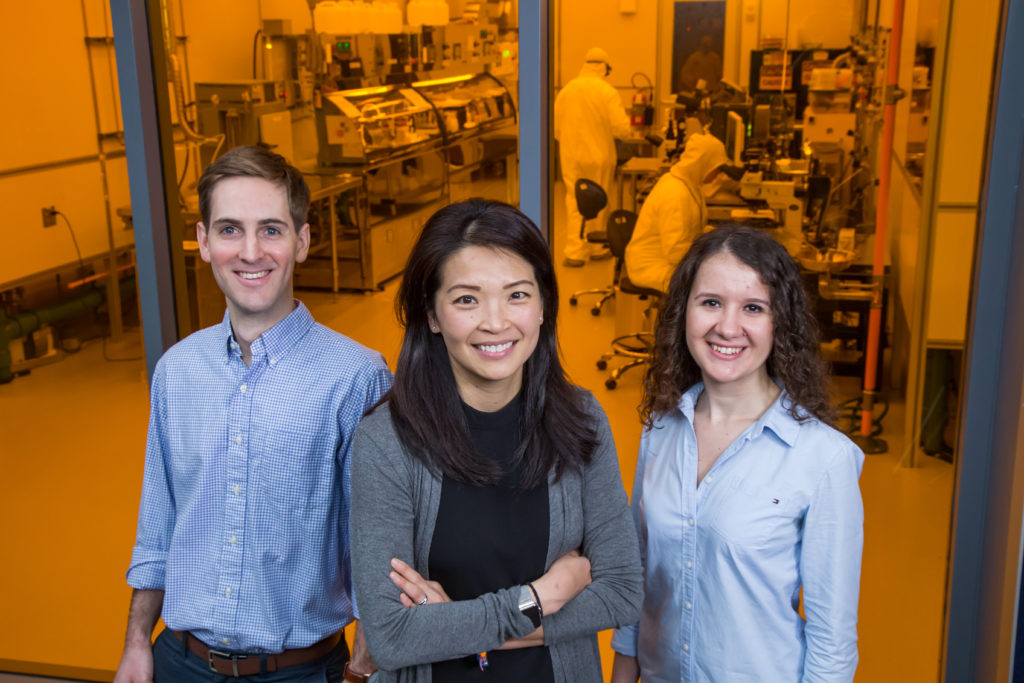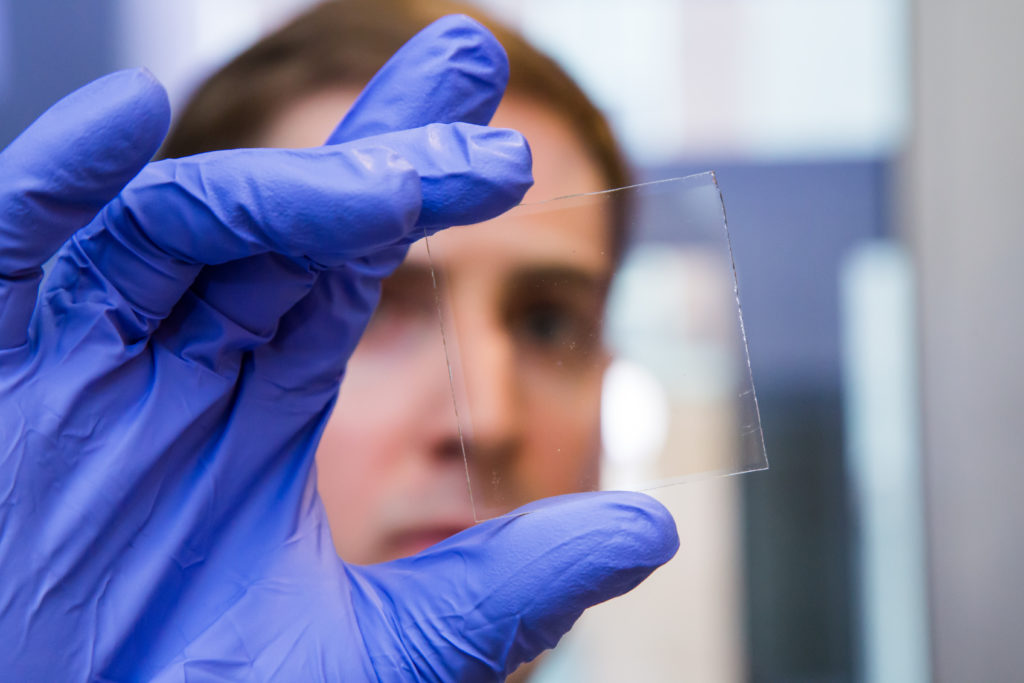
Princeton engineers invented a window system that could simultaneously generate electricity and lower heating and cooling costs. The team, led by Professor Yueh-Lin (Lynn) Loo, center, includes graduate students Nicholas Davy, left, and Melda Sezen-Edmonds, right. Behind them is a cleanroom at the Andlinger Center for Energy and the Environment, where Loo is the director. (Photo by David Kelly Crow)
Smart windows equipped with controllable glazing can augment lighting, cooling and heating systems by varying their tint, saving up to 40 percent in an average building’s energy costs.
These smart windows require power for operation, so they are relatively complicated to install in existing buildings. But by applying a new solar cell technology, researchers at Princeton University have developed a different type of smart window: a self-powered version that promises to be inexpensive and easy to apply to existing windows. This system features solar cells that selectively absorb near-ultraviolet (near-UV) light, so the new windows are completely self-powered.
“Sunlight is a mixture of electromagnetic radiation made up of near-UV rays, visible light, and infrared energy, or heat,” said Yueh-Lin (Lynn) Loo, director of the Andlinger Center for Energy and the Environment, and the Theodora D. ’78 and William H. Walton III ’74 Professor in Engineering. “We wanted the smart window to dynamically control the amount of natural light and heat that can come inside, saving on energy cost and making the space more comfortable.”
The smart window controls the transmission of visible light and infrared heat into the building, while the new type of solar cell uses near-UV light to power the system.
“This new technology is actually smart management of the entire spectrum of sunlight,” said Loo, who is a professor of chemical and biological engineering. Loo is one of the authors of a paper, published June 30, that describes this technology, which was developed in her lab.
Because near-UV light is invisible to the human eye, the researchers set out to harness it for the electrical energy needed to activate the tinting technology.
“Using near-UV light to power these windows means that the solar cells can be transparent and occupy the same footprint of the window without competing for the same spectral range or imposing aesthetic and design constraints,” Loo added. “Typical solar cells made of silicon are black because they absorb all visible light and some infrared heat – so those would be unsuitable for this application.”
In the paper published in Nature Energy, the researchers described how they used organic semiconductors – contorted hexabenzocoronene (cHBC) derivatives – for constructing the solar cells. The researchers chose the material because its chemical structure could be modified to absorb a narrow range of wavelengths – in this case, near-UV light. To construct the solar cell, the semiconductor molecules are deposited as thin films on glass with the same production methods used by organic light-emitting diode manufacturers. When the solar cell is operational, sunlight excites the cHBC semiconductors to produce electricity.

Graduate student Nicholas Davy holds a sample of the special window glass. (Photo by David Kelly Crow)
At the same time, the researchers constructed a smart window consisting of electrochromic polymers, which control the tint, and can be operated solely using power produced by the solar cell. When near-UV light from the sun generates an electrical charge in the solar cell, the charge triggers a reaction in the electrochromic window, causing it to change from clear to dark blue. When darkened, the window can block more than 80 percent of light.
Nicholas Davy, a doctoral student in the chemical and biological engineering department and the paper’s lead author, said other researchers have already developed transparent solar cells, but those target infrared energy. However, infrared energy carries heat, so using it to generate electricity can conflict with a smart window’s function of controlling the flow of heat in or out of a building. Transparent near-UV solar cells, on the other hand, don’t generate as much power as the infrared version, but don’t impede the transmission of infrared radiation, so they complement the smart window’s task.
Davy said that the Princeton team’s aim is to create a flexible version of the solar-powered smart window system that can be applied to existing windows via lamination.
“Someone in their house or apartment could take these wireless smart window laminates – which could have a sticky backing that is peeled off – and install them on the interior of their windows,” said Davy. “Then you could control the sunlight passing into your home using an app on your phone, thereby instantly improving energy efficiency, comfort, and privacy.”
Joseph Berry, senior research scientist at the National Renewable Energy Laboratory, who studies solar cells but was not involved in the research, said the research project is interesting because the device scales well and targets a specific part of the solar spectrum.
“Integrating the solar cells into the smart windows makes them more attractive for retrofits and you don’t have to deal with wiring power,” said Berry. “And the voltage performance is quite good. The voltage they have been able to produce can drive electronic devices directly, which is technologically quite interesting.”
Davy and Loo have started a new company, called Andluca Technologies, based on the technology described in the paper, and are already exploring other applications for the transparent solar cells. They explained that the near-UV solar cell technology can also power internet-of-things sensors and other low-power consumer products.
“It does not generate enough power for a car, but it can provide auxiliary power for smaller devices, for example, a fan to cool the car while it’s parked in the hot sun,” Loo said.
Besides Loo and Davy, Melda Sezen-Edmonds, a graduate student in chemical and biological engineering, is the co-author responsible for the electrochromic portion of the paper. Other authors are Jia Gao, a postdoctoral researcher in Loo’s group then, now with Enablence Technologies in California; Xin Lin, a graduate student in electrical engineering; Amy Liu, an undergraduate in computer science; Nan Yao, director of Princeton’s Imaging and Analysis Center; and Antoine Kahn, the Stephen C. Macaleer ’63 Professor in Engineering and Applied Science and vice dean of Princeton’s School of Engineering and Applied Science. Support for the project was provided in part by the National Science Foundation, and the Wilke Family Fund administered by the School of Engineering and Applied Science at Princeton.